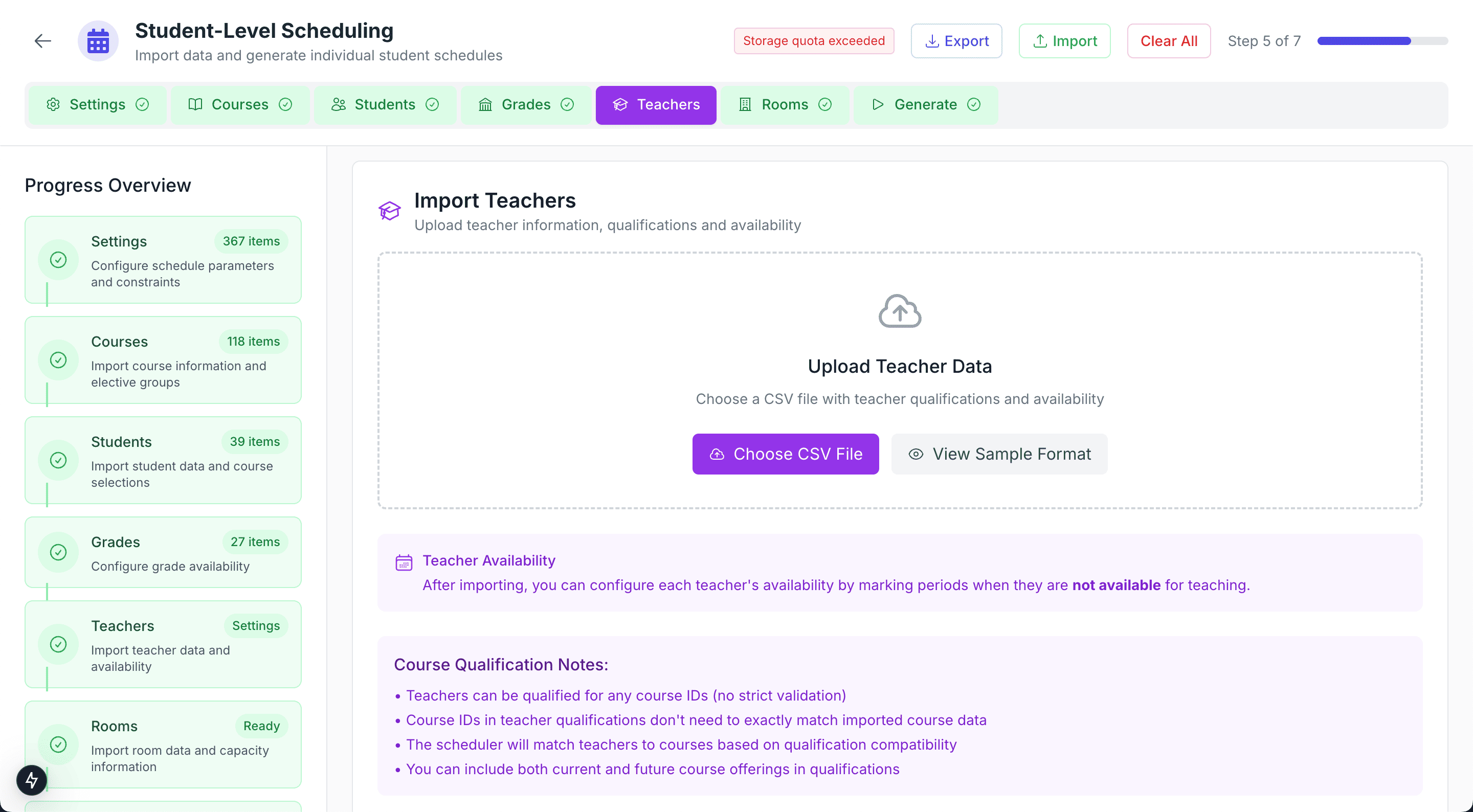Step 5: Faculty Configuration
Faculty configuration is where you define your teaching staff, their qualifications, availability, and workload limits. This information enables the system to assign the right teachers to appropriate courses while respecting their constraints and expertise.
Understanding Teacher Data Requirements
The Individual Student Schedule Generator needs comprehensive information about each teacher to make optimal assignments and create feasible schedules.

Faculty configuration interface showing teacher details and qualifications
Essential Teacher Information
Teacher ID: Unique identifier for each faculty member
- Use existing employee IDs when possible
- Maintain consistency with payroll and HR systems
- Include substitute teachers who may cover regular classes
Full Name: Complete name as it should appear on schedules
- Use formal names for professional documents
- Include titles (Dr., Mr., Ms.) if your institution uses them
- Consider how names display on student and parent communications
Department/Subject Area: Primary teaching specialization
- Mathematics, Science, English, Social Studies, etc.
- Helps organize teachers and validate course assignments
- Useful for reporting and administrative oversight
Course Qualifications
Subject Matter Qualifications
Qualified Courses: Specific courses the teacher can teach
- Must match course codes from your course catalog exactly
- Include all courses where the teacher has appropriate expertise
- List all subjects the teacher is qualified to handle
Qualification Strategy: Be generous when listing teacher qualifications. It's better to give the system more options and let it optimize assignments rather than create constraints that make scheduling impossible.
Teaching Load and Workload Limits
Maximum Periods Per Week: Total teaching periods the teacher can handle
- Consider full-time vs. part-time status
- Account for non-teaching duties (department head, coaching, etc.)
- Include preparation and grading time requirements
Preferred Teaching Load: Optimal number of periods for the teacher
- May be less than maximum to allow for quality instruction
- Consider teacher experience and course difficulty
- Balance veteran teachers with newer faculty members
Course Load Limits: Maximum sections of specific courses
- Some courses require extensive preparation (Advanced Chemistry, AP courses)
- Laboratory courses may have additional setup and cleanup time
- Creative courses might need individual student attention
Teacher Availability and Constraints
Daily Availability Patterns
Standard Availability: Periods when the teacher is normally available
- Full-time teachers: Usually available all periods except lunch
- Part-time teachers: Specific days or periods only
- Shared teachers: Split time between multiple schools
Blocked Periods: Times when the teacher cannot teach
- Administrative duties (department meetings, parent conferences)
- Other school responsibilities (coaching, club supervision)
- Personal commitments (medical appointments, family obligations)
Preferred Periods: Times when the teacher works most effectively
- Morning preference for intensive courses
- Afternoon preference for creative or discussion-based courses
- Consider teacher energy levels and teaching style
Workload Balance: Ensure teacher workloads are realistic and sustainable. Overloaded teachers cannot provide quality instruction, while underutilized teachers represent inefficient resource allocation.
Faculty Data Import Methods
Individual Teacher Entry
For smaller faculties or detailed customization:
- Add New Teacher: Click "Add Teacher" button
- Enter Basic Info: Teacher ID, name, and department
- Set Qualifications: Select qualified courses
- Configure Availability: Mark available periods and any restrictions
- Set Workload: Define maximum and preferred teaching loads
- Save Profile: Confirm teacher record
Bulk Faculty Import
For larger school systems, import via CSV file:
Basic Faculty CSV Structure:
Teacher_ID,Name,Department,Qualified_Courses,Max_Periods_Per_Week,Available_Days
T001,Sarah Johnson,Mathematics,"MATH-101,MATH-ADV,CALC-101",25,"Monday,Tuesday,Wednesday,Thursday,Friday"
T002,Michael Chen,Science,"BIO-101,BIO-LAB,CHEM-101,PHYS-101",30,"Monday,Tuesday,Wednesday,Thursday,Friday"
T003,Emma Rodriguez,English,"ENG-101,ENG-ADV,LIT-MOD,WRIT-CRE",28,"Monday,Tuesday,Wednesday,Thursday,Friday"
Advanced CSV with Availability:
Teacher_ID,Name,Department,Qualified_Courses,Max_Periods,Blocked_Periods,Preferred_Periods
T001,Sarah Johnson,Math,"MATH-101,CALC-101",25,"Monday-P1,Friday-P8","Tuesday-P2,Wednesday-P3"
Import Validation and Quality Checks
Automatic Validation:
- Teacher IDs are unique
- Qualified courses exist in course catalog
- Workload limits are reasonable
- Availability periods align with school schedule
Common Issues:
- Course codes don't match catalog entries
- Workload exceeds available periods
- No teachers qualified for required courses
- Insufficient total teaching capacity for student demand
Next Steps
With faculty information configured, you're ready to move to Rooms Configuration where you'll set up your physical facilities and their capabilities.
Quick Checklist:
- All teaching staff entered with complete information
- Course qualifications match available courses
- Teacher availability periods are realistic
- Workload limits allow for quality instruction
- Special requirements and constraints noted
- Faculty data validates without errors